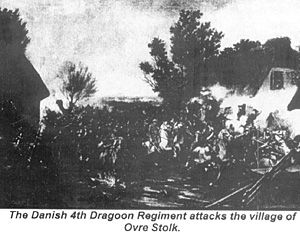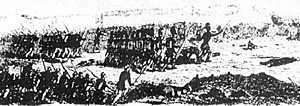(which appeared in the Times, 30th July 1850)
Schleswig, July 24.
 "The first engagement between the Danes and the army of the Duchies since the commencement of hostilities took place this morning about two miles and a half in advance of General Willisen's main position. His center has been for some days at Idstedt; and expecting a movement forward on the part of the Danes he yesterday occupied a thickly wooded height called Popholz, stretching east of the high road to Flensburg, and something more than two miles from Idstedt, with a body of Chasseurs, but with no intention of holding it. It was known that the Danes intended to send forward part of their forces to reconnoiter the ground, if not to attack the main body of the Holstein army.
"The first engagement between the Danes and the army of the Duchies since the commencement of hostilities took place this morning about two miles and a half in advance of General Willisen's main position. His center has been for some days at Idstedt; and expecting a movement forward on the part of the Danes he yesterday occupied a thickly wooded height called Popholz, stretching east of the high road to Flensburg, and something more than two miles from Idstedt, with a body of Chasseurs, but with no intention of holding it. It was known that the Danes intended to send forward part of their forces to reconnoiter the ground, if not to attack the main body of the Holstein army.
This morning at an early hour the infantry remaining in the town of Schleswig were sent to the front; the last battalion left the town between 8 and 9 o'clock. By that time it was reported that the Danes were advancing, and everybody was on the alert. The General and his staff were some half mile further forward than Idstedt, in the middle of the plain, to the right of the Chaussée. A large mound, one of the many tumuli that are scattered over this part of the country and are called the "Huns' graves" was the only elevation that commanded a good view of the wood directly in front, and upon and around the headquarters for the time was placed. The spot is a hard hour's ride from Schleswig.
I again made use of the permission to follow headquarters, and arrived at the mound about 10 o'clock. All was quiet, though every moment the commencement of the firing was expected. The Danes had sent forward two or three guns and a body of infantry and riflemen through Siverstedt and Stendrup, and they were advancing by the Chaussée to Popholz; the woody hill that bounded the horizon to the north was the point to which all the glasses were turned. The staff had been out since 7 in the morning and by 11 o'clock the day had grown oppressively warm though a smart breeze from the east cooled the air a little.
Most of the officers were sitting or lying on the heath with which the mount is grown over; some score of dismounted dragoons and orderlies in attendance were walking their horses up and down the level field. The General was standing half-way up the mound conversing with the officers last arrived from the front, and those who had nothing to do had lit their cigars and prepared for another hour of inaction.
Somebody suggested a glass of wine from a supply at hand, and we were just drawing the cork when the report of a cannon from the end of the wood nearest the highest road brought us to our feet. The head of the Danish column had shown itself and was diverging from the road towards the wood; the balls from the Holstein guns, of which them were but two, must have crossed the Chaussée obliquely, but at the distance we could not see the Chaussée itself, there being some rising ground between us and it.
 The Danes returned the fire from apparently an equal number of guns, and for about 20 minutes the cannonade was very sharp; no great harm was done, though the parties were within good shot range of each other; we could distinctly see the Danish cannonballs strike the ground and throw up clouds of dust as they bounded along the light sandy soil. In the meantime the Chasseurs in the wood had opened an irregular fire on the Danish skirmishers; but as the latter attacked from the other side of the wooded ridge and the Holsteiners were posted in the wood itself, we could see nothing but the smoke rising in white clouds at every shot from between the dark green beech trees.
The Danes returned the fire from apparently an equal number of guns, and for about 20 minutes the cannonade was very sharp; no great harm was done, though the parties were within good shot range of each other; we could distinctly see the Danish cannonballs strike the ground and throw up clouds of dust as they bounded along the light sandy soil. In the meantime the Chasseurs in the wood had opened an irregular fire on the Danish skirmishers; but as the latter attacked from the other side of the wooded ridge and the Holsteiners were posted in the wood itself, we could see nothing but the smoke rising in white clouds at every shot from between the dark green beech trees.
The cannonade ceased, and the Chasseurs, according to their orders, withdrew from the woods towards us, firing as they retired, but not so rapidly. The guns were brought back to our left and posted so as to sweep the high road northwards; a squadron of cavalry that had been sent forward, but had not been engaged,. took up its position in front of us and to our right, but the Danes made no attempt to advance beyond the wood, and after an hour's silence the officers decided that nothing more could be done today.
Could the Danes have been drawn forward into the plain south of Popholz, and in front of the real main position of the Holsteiners, the action might have become general. But they advanced no further than the edge of the wood. The whole affair did not last more than half an hour. In that time, the Holsteiners army lost eight men, killed and wounded, as far as, is the hurry of the moment could be ascertained.
During the attack the commander of the 2ndDivision, Schleppegrell, was killed.8 o'clock p.m. The prediction that all was over for the day was not verified. It was reported in Schleswig at 3 o'clock that the engagement had been resumed, and I rode out again to the mound or head-quarters at Idstedt, and in the way met but too many proofs that the fighting had been more severe than this morning in the carts conveying the wounded to the hospital prepared in the Schloss in Schleswig itself.
In order to ascertain what force the Danes had thrown into the wood of Popholz and the hills about Helligbek, a little village to the west of it, a Holstein battery and some infantry were ordered forward, the village was cannonaded, and in a short time the engagement became more serious than was intended, owing, it is said, to the impatience of the troops.
But the Danes held both positions against the attack, and the infantry were recalled. The second engagement was over about 6 o'clock. The battery, that commands the village or rather hamlet of Helligbek, was relieved, and I rode back with it on the road to Schleswig as far as the point where it turned off to join the brigade of the main body to which it belongs. The battery had fired almost 30 shots into the village and had sustained no loss, the infantry having ventured in and about the wood.
More to the west the Danes have advanced along the river Treene towards Ballingstedt, and in this direction, too, there has been a cannonade all the afternoon that did not quite cease till 7 o'clock. From the sound it was evident there were heavier guns in action, and it is stated the Danes have some 18 or 24 pounders in their batteries. Here, too, the outposts only have been engaged, and the Danes have advanced no further than north of Ballingstedt.
The country in this direction is open and level, and as the Holsteiners are weak in cavalry they will probably not attempt any attack on the Danes there tomorrow. On every other part of the line the decisive battle is expected to commence at daybreak. The Danes have a superiority in force, it is calculated, of about 4,000. The Holsteiners are in good spirits, and the officers say they are cool and steady under fire. No one here appears to doubt that the Danes must be beaten, but any anticipation of military events is very hazardous.
The general result of the operations of to-day is, that the Danish force has advanced, and has been allowed to occupy a post in front, whence an attempt was afterwards made to drive them that did not succeed; and that they have also advanced considerably on the left flank and with some hard fighting. On the other hand, the Holsteiners have lost none of their chief positions, all the skirmishing having been in advance of them."
More Battle of Isted (Idsted)
-
Introduction
Report on Battle of 24th July 1850
Report on Main Battle of 25th July 1850
Jumbo Map (extremely slow: 137K)
Back to Clash of Empires No. 7/8 Table of Contents
Back to Clash of Empires List of Issues
Back to Master Magazine List
© Copyright 2000 by Keith Frye
This article appears in MagWeb (Magazine Web) on the Internet World Wide Web.
Other military history articles and gaming articles are available at http://www.magweb.com